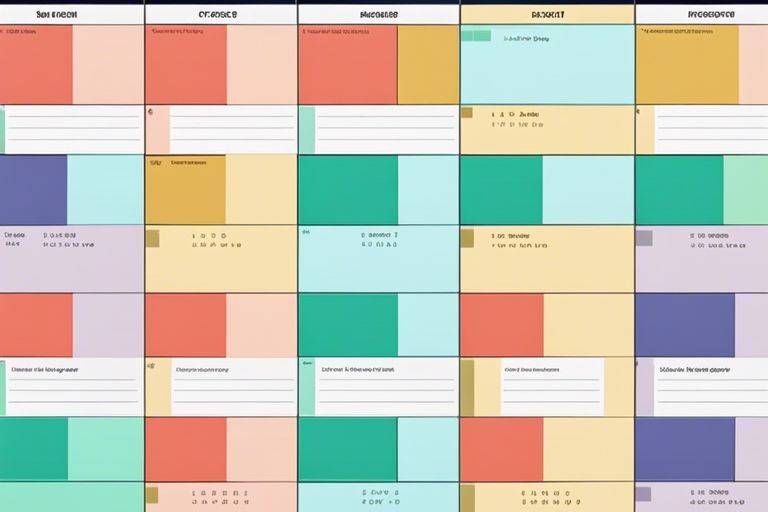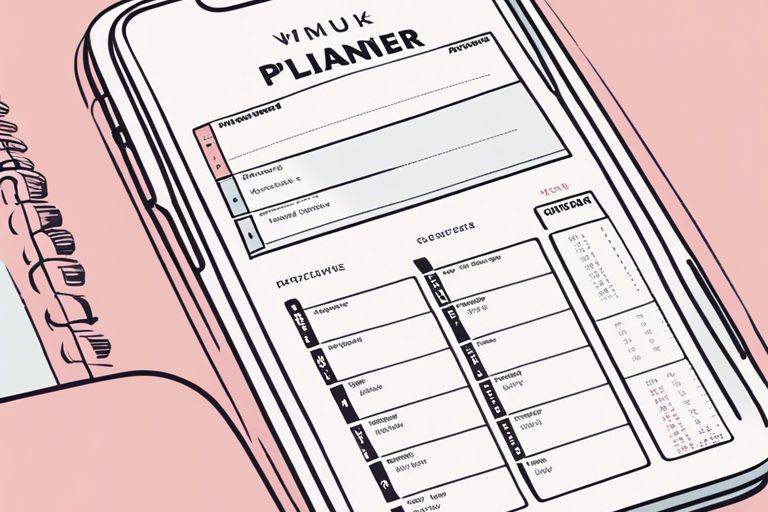Time Blocking! You’ve probably experienced those days where you end up feeling overwhelmed with an endless to-do list and not enough time to accomplish everything. This is where time blocking can be a game-changer. By assigning specific time slots for each task or activity, you can increase productivity, reduce procrastination, and improve time management skills. In this ultimate guide, we will examine into the concept of time blocking, its benefits, and how you can implement it effectively in your daily routine.
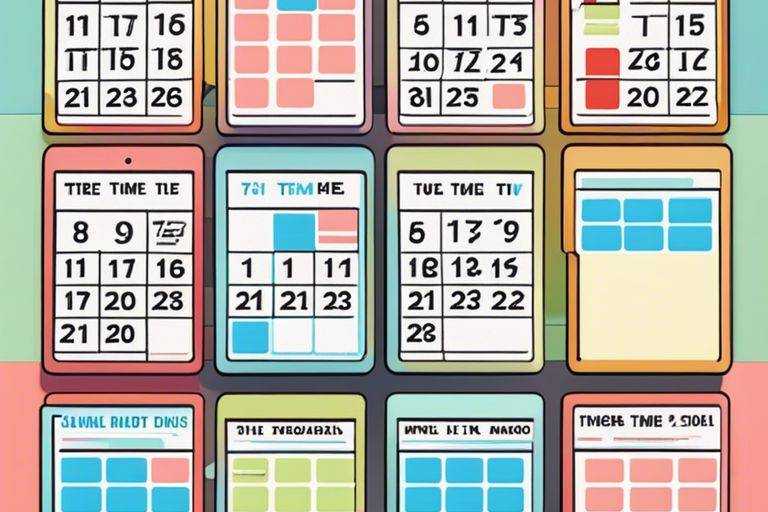
Key Takeaways:
- Time blocking is a powerful time management technique that involves allocating specific time slots for tasks.
- By setting aside dedicated time for each task, you can improve focus, productivity, and efficiency.
- It is important to create a detailed schedule that includes everything from work tasks to personal activities.
- Be realistic when allocating time for tasks and allow for breaks and buffer time between activities.
- Use a digital calendar or planner to organize and track your time blocks for better visibility and time management.
- Regularly review and adjust your time blocks to accommodate changes in priorities or unexpected events.
- Consistency is key when it comes to time blocking – make it a habit to stick to your schedule as much as possible.
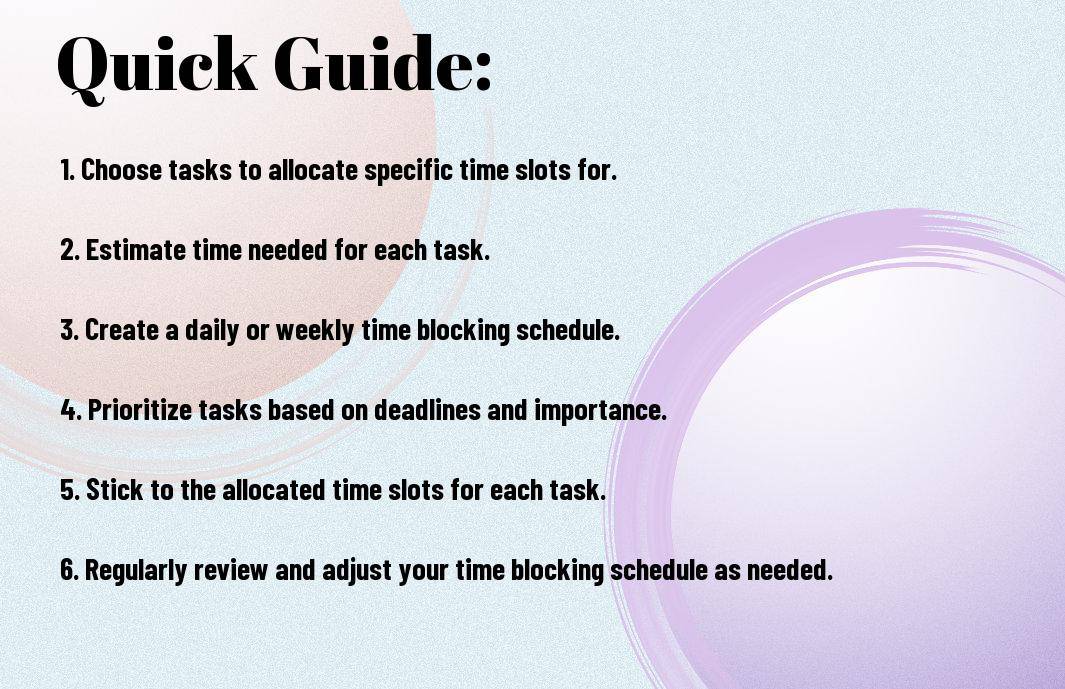
The Fundamentals of Time Blocking
Definition and Core Principles
If you want to take control of your time and maximize your productivity, time blocking is the strategy for you. Time blocking is a time management method where you divide your day into blocks of time dedicated to specific tasks or activities. The core principles of time blocking include setting aside specific blocks of time for important tasks, minimizing distractions during those blocks, and sticking to the predetermined schedule.
Types of Time Blocking
There are different types of time blocking techniques that you can use based on your preferences and work style. The most common types include day-based time blocking, task-based time blocking, and hybrid time blocking. Day-based time blocking involves allocating specific tasks to designated days of the week. Task-based time blocking focuses on assigning time blocks to individual tasks, regardless of the day. Hybrid time blocking combines elements of both approaches, offering flexibility and structure.
- Day-based time blocking organizes tasks by designated days of the week.
- Task-based time blocking assigns time blocks to individual tasks.
- Hybrid time blocking combines elements of both approaches for flexibility.
After trying each type, you can determine which method works best for your schedule and helps you optimize your productivity.
| Day-based Time Blocking | Task-based Time Blocking |
| Organizes tasks by designated days of the week. | Assigns time blocks to individual tasks. |
| Helps in creating a structured routine. | Allows for flexibility in task prioritization. |
| May lead to inflexibility in task allocation. | Requires efficient task management skills. |
| Encourages batch processing of similar tasks. | Aids in breaking down complex projects. |
| Enables better focus on specific tasks. | Promotes adaptability in tackling changing priorities. |
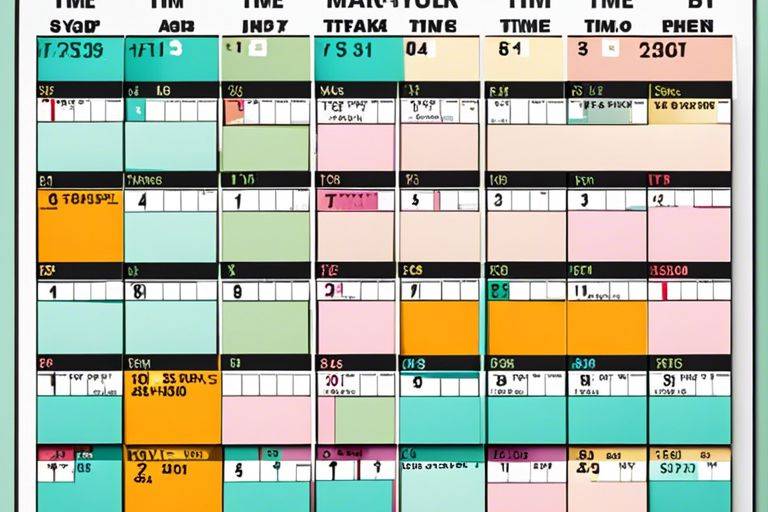
Step-by-Step Guide to Time Blocking
Many individuals find it challenging to manage their time effectively in today’s fast-paced world. Time blocking is a powerful technique that can help you take control of your schedule by allocating specific time slots for tasks. By breaking down your day into organized blocks of time, you can increase productivity, reduce procrastination, and improve focus on important tasks.
Getting Started with Time Blocking
While time blocking may seem intimidating at first, it is a straightforward process that can yield significant benefits. To begin, create a list of all the tasks you need to accomplish during the day. This can include work assignments, household chores, personal activities, and any other responsibilities you have. Once you have a comprehensive list, you can start allocating specific time slots to each task.
In the beginning, it’s necessary to start simple and be realistic with your time estimates. Overestimating the time needed for a task can lead to frustration and derail your entire schedule. As you become more comfortable with time blocking, you can refine your approach and adjust your time blocks accordingly.
The Time Blocking Process
Assuming you have your task list ready, the next step is to divide your day into blocks of time and assign specific tasks to each block. This process requires careful planning and prioritization to ensure that you allocate enough time for necessary activities. It’s crucial to focus on one task at a time during each time block to maximize productivity and avoid distractions.
Time blocking allows you to create a visual representation of your day, making it easier to see where your time is being spent. This technique can help you identify patterns of inefficiency and areas where you can improve. By setting boundaries and sticking to your schedule, you can avoid overcommitting and ensure that you have dedicated time for both work and personal life.

Advanced Techniques in Time Blocking
- Prioritization within Time Blocks:
Technique Description Pomodoro Technique Break your work into intervals with short breaks in between to enhance focus. Eisenhower Matrix Sort tasks based on urgency and importance to prioritize effectively.
Prioritization within Time Blocks
Advanced time blockers understand the importance of prioritizing tasks within each time block to optimize productivity. Utilizing techniques such as the Pomodoro Technique, which breaks work into intervals with short breaks, can help maintain focus and enhance efficiency. Additionally, the Eisenhower Matrix is a valuable tool to categorize tasks based on urgency and importance, allowing for better decision-making on what to tackle first within a time block.
Overcoming Common Time Blocking Challenges
On the journey of time blocking, it’s common to face challenges that can disrupt your schedule. Distractions, procrastination, and unexpected interruptions are some of the obstacles that individuals encounter. To combat these challenges, establish a dedicated workspace, eliminate distractions, and communicate your time block schedule with others to create a supportive environment.
Techniques: Implementing the Pomodoro Technique can help in increasing focus and combatting distractions during time blocks. Setting boundaries and creating a supportive environment can aid in overcoming common challenges such as procrastination and interruptions. Remember that consistency is key when incorporating advanced techniques to enhance your time blocking productivity.
Factors to Consider for Effective Time Blocking
For successful implementation of time blocking, there are certain factors that need to be taken into consideration.
- Individual Productivity Rhythms
- Work Environment and Distractions
Recognizing these factors will help you maximize the efficiency and effectiveness of your time blocking strategy.
Individual Productivity Rhythms
Any effective time blocking strategy must account for individual productivity rhythms. Understanding when you are most productive during the day can help you allocate the right tasks to the right time slots. Some people are more focused in the morning, while others hit their peak in the afternoon or evening. By recognizing your own productivity patterns, you can schedule your most important tasks during your peak hours.
Work Environment and Distractions
Any effective time blocking strategy must also consider the work environment and potential distractions. Your work environment plays a crucial role in your productivity levels. Minimize distractions by setting up a designated workspace that is free from interruptions. Identify common distractions and find ways to eliminate or reduce them during your blocked time slots. Additionally, consider the noise level, lighting, and comfort of your workspace to optimize your focus and concentration.
Another important aspect to consider is the impact of digital distractions. In today’s hyperconnected world, it’s easy to get sidetracked by emails, social media notifications, and other online distractions. Set boundaries by turning off notifications and dedicating specific time slots for checking emails and messages.
Pros and Cons of Time Blocking
Advantages of Time Blocking
Now, let’s look into the advantages of time blocking. It allows you to allocate specific time slots for each task, helping you prioritize and focus on one task at a time. By breaking your day into chunks of time dedicated to different activities, you can enhance productivity and efficiency. Time blocking also helps in better time management and reduces decision fatigue, as you already have a plan set for the day.
| Pros | Cons |
Disadvantages of Time Blocking
Cons of time blocking include the rigidity of sticking to a predefined schedule, which can be challenging for people who prefer a more flexible approach to their day. Additionally, unexpected interruptions or tasks may disrupt your planned schedule, leading to time management issues. It can also be overwhelming for some individuals to plan every minute of their day, causing stress and burnout.
Another downside of time blocking is that it may not work for everyone’s work style or personality. Some people thrive in a more spontaneous work environment, where they can tackle tasks as they come up rather than following a strict schedule. It’s important to assess your own preferences and adapt time blocking to suit your needs for optimal results.
Tips for Successful Time Blocking
To master the art of time blocking, here are some important tips to help you stay on track and make the most out of your allocated time:
- Plan Ahead: Before you start your day, take a few minutes to plan out your tasks and allocate specific time slots for each.
- Eliminate Distractions: Find a quiet and clutter-free workspace to help you focus on the task at hand without interruptions.
- Stay Flexible: While it’s important to stick to your time blocks, it’s also crucial to be adaptable and adjust your schedule as needed.
- Review and Reflect: At the end of the day, review how you spent your time and reflect on what worked well and what needs improvement.
Assume that consistency is key in making time blocking a successful productivity tool. With practice and dedication, you can streamline your workflow and achieve your goals efficiently.
Tools and Resources for Time Blocking
You can utilize various tools and resources to enhance your time blocking experience. Popular tools like Google Calendar, Trello, or Notion can help you organize your tasks and create visual schedules for better time management. Additionally, apps like Forest or Focus@Will can assist in minimizing distractions and boosting your focus during time blocks.
Building the Habit and Maintaining Consistency
You can build the habit of time blocking by starting small and gradually increasing the complexity of your schedules. Set reminders and alarms to prompt you to transition between different tasks. Do not forget, consistency is crucial in making time blocking a regular part of your routine. By committing to your schedule and practicing it daily, you can train your mind to adapt to this productive method.
Final Words
Summing up, time blocking is a powerful technique that can significantly boost productivity and efficiency by allocating specific time slots for tasks. By dedicating focused blocks of time to important activities, individuals can reduce distractions, increase concentration, and accomplish more in less time. This ultimate guide has provided tips and strategies to help you implement time blocking effectively in your daily routine. For more insights, you can also check out 7 Tips to Start Time Blocking Today [2024].
FAQ
Q: What is Time Blocking?
A: Time blocking is a time management method where you divide your day into blocks of time dedicated to specific tasks or activities.
Q: How does Time Blocking help with productivity?
A: Time blocking helps improve productivity by allowing you to focus on one task at a time, minimizing distractions, and ensuring that important tasks are given priority.
Q: How do I start Time Blocking?
A: To start time blocking, create a daily schedule and allocate specific time slots for tasks based on their priority and estimated duration.
Q: What are the benefits of Time Blocking?
A: The benefits of time blocking include better time management, increased productivity, improved focus, reduced procrastination, and a sense of accomplishment.
Q: How can I effectively implement Time Blocking?
A: To effectively implement time blocking, be realistic about the time needed for each task, eliminate distractions during blocked time, and regularly review and adjust your schedule as needed.
Q: Can Time Blocking help with work-life balance?
A: Yes, time blocking can help with work-life balance by allowing you to allocate time for work, personal activities, relaxation, and self-care, ensuring a more well-rounded and fulfilling life.
Q: What are some tips for successful Time Blocking?
A: Some tips for successful time blocking include setting clear goals for each time block, grouping similar tasks together, taking breaks between blocks, and being flexible when unexpected tasks arise.
Expand Your Mind
Zero-Based Calendar – Strategically Schedule Every Minute for Unparalleled Productivity
The One Thing – Gary Keller and Jay Papasan’s Focus on Making Everything Else Easier
Timeboxing – The Effective Limitation of Time Spent on Tasks
Breakdown Method – Tackling Overwhelming Tasks by Breaking Them Down
The 1-3-5 Rule – A Strategy to Balance Task Completion Across Complexity
